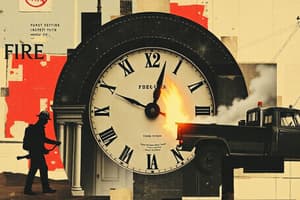Podcast
Questions and Answers
What was the year when the first fire department in Manila was established?
What was the year when the first fire department in Manila was established?
- 1900 (correct)
- 2008
- 1940
- 1977
Which act established a separate Bureau of Fire Protection in the Philippines?
Which act established a separate Bureau of Fire Protection in the Philippines?
- Republic Act No. 9514
- Republic Act No. 1975
- Republic Act No. 1940
- Republic Act No. 6975 (correct)
What is the most dangerous aspect of fire mentioned in the text?
What is the most dangerous aspect of fire mentioned in the text?
- A small fire can produce enough smoke to fill a building
- Darkness makes it life threatening
- Fire spreads quickly
- People die because of the smoke and toxic gases (correct)
What percentage of oxygen in the air is normal?
What percentage of oxygen in the air is normal?
What does fire need to make the fuel ignite and burn?
What does fire need to make the fuel ignite and burn?
Which element is required for fire but at least 16% and preferably 21%?
Which element is required for fire but at least 16% and preferably 21%?
What type of materials are classified under Class A in terms of fire safety?
What type of materials are classified under Class A in terms of fire safety?
What type of heat transfer involves the movement of heated fluids spreading the fire to other objects?
What type of heat transfer involves the movement of heated fluids spreading the fire to other objects?
During which stage of a fire does the smoke layer become thicker and the fire spreads to other furniture?
During which stage of a fire does the smoke layer become thicker and the fire spreads to other furniture?
What is the main purpose of using foam in fire extinguishing?
What is the main purpose of using foam in fire extinguishing?
Which of the following is NOT a class of fire based on the content provided?
Which of the following is NOT a class of fire based on the content provided?
What happens during the flash over stage of a fire?
What happens during the flash over stage of a fire?
Flashcards
Bureau of Fire Protection (BFP)
Bureau of Fire Protection (BFP)
Established in 1900, it protects lives and property from fire and other emergencies.
What is Fire?
What is Fire?
Rapid oxidation of a material, producing heat and light.
Fire Triangle Elements
Fire Triangle Elements
Oxygen, heat, and fuel are the three elements needed to start and sustain a fire.
Tetrahedron of Fire
Tetrahedron of Fire
Signup and view all the flashcards
Incipient Stage
Incipient Stage
Signup and view all the flashcards
Fully Developed Stage
Fully Developed Stage
Signup and view all the flashcards
Conduction
Conduction
Signup and view all the flashcards
Convection
Convection
Signup and view all the flashcards
Radiation
Radiation
Signup and view all the flashcards
Class A Fire
Class A Fire
Signup and view all the flashcards
Class B Fire
Class B Fire
Signup and view all the flashcards
PASS
PASS
Signup and view all the flashcards
Study Notes
Brief History of Bureau of Fire Protection (BFP)
- 1900: First fire department established in Manila
- 1940: Fire departments established in neighboring cities and towns
- 1975: Integration of local fire departments in the city
- 1977: First fire code in the Philippines enacted
- 1990: Republic Act No. 6975 established a separate Bureau of Fire Protection
- 2008: Republic Act No. 9514 revised fire code of the Philippines enacted
What is Fire?
- Fire is a rapid, self-sustaining oxidation process of combustible materials
- Accompanied by the evolution of heat and light of varying intensity
- Fire spreads quickly, becoming life-threatening in 2 minutes and engulfing in flames in 5 minutes
- Fire produces deadly smoke and toxic gases, making it difficult to breathe and causing disorientation
Elements of Fire
- Oxygen: at least 16% required, but normal is 21%
- Heat: enough to make the fuel ignite and burn
- Fuel: something that burns, such as paper, plastic, cloth, wood, or flammable liquids like alcohol
Tetrahedron of Fire
- Oxygen sources: some fuel materials contain oxygen to support burning
- Heat sources: open flames, sun, hot surfaces, sparks, arcs, friction, chemical action, electrical energy, and compression of gases
- Fuel: solid, liquid, or gas
Stages of Fire
- Ignition/incipient stage: fire is small, hard to detect, and confined to the fuel that ignited
- Growth stage: temperature and smoke increase, oxygen level decreases, and fuel is dried out
- Flashover stage: huge smoke is present, and fire is spreading to other furniture
- Fully developed stage: all materials are burning, and maximum heat is released
- Decay stage: intensity of fire is decreasing due to lack of fuel
How Fire Spreads
- Direct heat transfer (conduction)
- Convection: transfer of heat through the movement of heated fluids
- Radiation: transfer of heat through electromagnetic waves
Classes of Fire
- Class A: ordinary combustible materials (wood, cloth, paper, plastic, etc.)
- Class B: flammable or combustible liquids (gasoline, alcohol, paint, hairspray, etc.)
- Class C: energized electrical equipment (electric fan, microwave, TV, stove, etc.)
- Class D: combustible metals (magnesium, titanium, sodium, potassium, etc.)
- Class K: cooking media
How to Put Out a Fire
- Cooling: reducing temperature
- Smothering: excluding oxygen
- Fuel removal: removing the fuel source
- Inhibition: breaking the chemical reaction
- Reduction of heat: using something that absorbs heat, such as water or foam
- Exclusion of oxygen: closing the door, diluting oxygen, or blanketing with a wet blanket or foam
- Removal of fuel: turning off fuel supply or moving combustible materials
- Inhibition of chain reaction: breaking the chain reaction
Fire Extinguisher Use
- P: Pull the pin
- A: Aim at the base of the fire
Studying That Suits You
Use AI to generate personalized quizzes and flashcards to suit your learning preferences.



